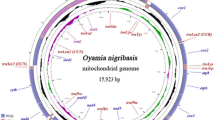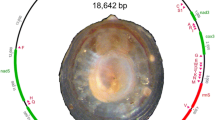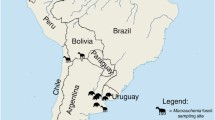Abstract
A region of mitochondrial DNA, including the 3′ end of tRNA phenylalanine, the complete 12S rRNA and tRNA valine genes, and the 5′ end of 16S rRNA, was sequenced for four phalangerids and one burramyid; additional marsupial sequences were extracted from GenBank. Parsimony, minimum evolution, and maximum likelihood analyses show that the ground cuscus, Phalanger gymnotis, groups with the tribe Phalangerini, not with the tribe Trichosurini as had been suggested on the basis of certain morphological characters. This result is in agreement with an earlier study using DNA hybridization and is supported by some morphological evidence as well. We conclude that the character states that link the ground cuscus with the Trichosurini are the result of convergence, and therefore the placement of several other species in the trichosurin genus Strigocuscus based on the same characters should be reconsidered. The hypothesized close relationship of two fossil taxa, Strigocuscus reidi and S. notialis, to Phalanger gymnotis is also questionable because the fossils do not share morphological synapomorphies that link the ground cuscus to the Phalangerini.
Similar content being viewed by others
LITERATURE CITED
Anderson, S., de Bruijn, M. H. L., Coulson, A. R., Eperon, I. C., Sanger, F., and Young, I. G. (1982). Complete sequence of bovine mitochondrial DNA. Conserved features of the mammalian mitochondrial genome. J. Mol. Biol. 156: 683–717.
Archer, M. (1984). The Australian marsupial radiation. In: Vertebrate Zoogeography and Evolution in Australasia, M. Archer and G. Clayton, eds., pp. 633–808, Hesperian Press, Carlisle, Western Australia.
Archer, M., Hand, S., and Godthelp, H. (1991). Riversleigh, the Story of Animals in Ancient Rainforests of Inland Australia, Reed Books, New South Wales, Australia.
Baverstock, P. (1984). The molecular relationships of Australian possums and gliders. In: Possums and Gliders, A. Smith and I. Hume, eds., pp. 1–8, Surrey Beatty and Sons, Chipping Norton, Australia.
Bremer, K. (1988). The limits of amino acid sequence data in angiosperm phylogenetic reconstruction. Evolution 42(4): 795–803.
Burk, A., Westerman, M., and Springer, M. (1998). The phylogenetic position of the musky rat-kangaroo and the evolution of bipedal hopping in kangaroos (Macropodidae: Diprotodontia). Syst. Biol. 47(3): 457–474.
Colgan, D., Flannery, T. F., Trimble, J., and Aplin, K. (1993). Electrophoretic and morphological analysis of the systematics of the Phalanger orientalis (Marsupialia) species complex in Papua New Guinea and the Solomon Islands. Aust. J. Zool. 41: 355–378.
DeRijk, P., Van de Peer, Y., Chapella, S., and Wachter, R. D. (1994). Database on the structure of the large ribosomal subunit RNA. Nucleic Acids Res. 22: 3495–3501.
Felsenstein, J. (1981). Evolutionary trees from DNA sequences: a maximum likelihood approach. J. Mol. Evol. 17: 368–376.
Felsenstein, J. (1985). Confidence limits on phylogenies: An approach using the bootstrap. Evolution 39(4): 783–791.
Flannery, T. (1994). Possums of the World. A Monograph of the Phalangeroidea, GEO Productions, Chatswood, New South Wales, Australia.
Flannery, T. (1995). Mammals of the South-West Pacific and Moluccan Islands, Cornell University Press, Ithaca, NY.
Flannery, T., and Archer, M. (1987). Strigocuscus reidi and Trichosurus dicksoni, two new fossil phalangerids (Marsupialia: Phalangeridae) from the Miocene of northern Queensland. In: Possums and Opossums: Studies in Evolution, M. Archer, ed., pp. 527–536, Surrey Beatty and Sons, Chipping Norton, Australia.
Flannery, T., Archer, M., and Maynes, G. (1987a). The phylogenetic relationships of living phalangerids (Phalangeroidea: Marsupialia) with a suggested new taxonomy. In: Possums and Opossums: Studies in Evolution, M. Archer, ed., pp. 477–506, Surrey Beatty and Sons, Chipping Norton, Australia.
Flannery, T., Rich, T. H. R., Turnbull, W., and Lundelius, E., Jr. (1987b). The phalangerids (Marsupialia: Phalangeridae) of the Early Pliocene Hamilton local fauna, southwestern Victoria. In: Possums and Opossums: Studies in Evolution, M. Archer, ed., pp. 537–546, Surrey Beatty and Sons, Chipping Norton, Australia.
George, G. G. (1982). Cuscuses Phalanger spp.: Their management in captivity. In: The Management of Australian Mammals in Captivity, D. D. Evans, ed., pp. 67–72, Zoological Board of Victoria, Melbourne.
George, G. G. (1987). Characterisation of the living species of cuscus (Marsupialia: Phalangeridae). In: Possums and Opossums: Studies in Evolution, M. Archer, ed., pp. 507–526, Surrey Beatty and Sons, Chipping Norton, Australia.
Hasegawa, M., Kishino, H., and Yano, T. (1985). Dating the human-ape splitting by a molecular clock of mitochondrial DNA. J. Mol. Evol. 22: 160–174.
Hayman, D. L., and Martin, P. G. (1974). Mammalia I: Monotremata and Marsupialia. In: Animal Cytogenetics, Vol. 4: Chordata 4, J. Bernard, ed., pp. 1–109, Gebruder Borntrager, Berlin.
Higgins, D. G., and Sharp, P. M. (1988). CLUSTAL: A package for performing multiple sequence alignment on a microcomputer. Gene 73: 237–244.
Kirsch, J. A. W., and Springer, M. S. (1993). Timing of the molecular evolution of New Guinean marsupials. Sci. New Guinea 19(3): 147–156.
Kirsch, J. A. W., Springer, M. S., Krajewski, C., Archer, M., Aplin, K., and Dickerman, A. W. (1990). DNA/DNA hybridization studies of the carnivorous marsupials. I. The intergeneric relationships of bandicoots (Marsupialia: Perameloidea). J. Mol. Evol. 30: 434–448.
Kirsch, J. A. W., Lapointe, F.-J., and Springer, M. S. (1997). DNA-hybridisation studies of marsupials and their implications for metatherian classification. Aust. J. Zool. 45: 211–280.
Kishino, H., and Hasegawa, M. (1989). Evaluation of the maximum likelihood estimate of the evolutionary tree topologies from DNA sequence data, and the branching order in Hominoidea. J. Mol. Evol. 29: 170–179.
Krajewski, C., and Dickerman, A. W. (1990). Bootstrap analysis of phylogenetic trees derived from DNA hybridization distance. Syst. Zool. 39: 383–390.
Lapointe, F. J., Kirsch, J. A. W., and Bleiweiss, R. (1994). Jackknifing of weighted trees: Validation of phylogenies constructed from distance matrices. Mol. Phylogenet. Evol. 3: 256–267.
Norris, C. A. (1994). The periotic bones of possums and cuscuses: cuscus polyphyly and the division of the marsupial family Phalangeridae. Zool. J. Linn. Soc. 111: 73–98.
Pearson, J. (1950). The relationships of the Potoroidae to the Macropodidae (Marsupialia). Pap. Proc. R. Soc. Tasmania 1949: 211–229.
Prager, E. M., and Wilson, A. C. (1988). Ancient origin of lactalbumin from lysozyme: Analysis of DNA and amino acid sequences. J. Mol. Evol. 27: 326–335.
Rzhetsky, A., and Nei, M. (1992). A simple method for estimating and testing minimum-evolution trees. Mol. Biol. Evol. 9(5): 945–967.
Springer, M. S. (1997). Molecular clocks and the timing of the placental and marsupial radiations in relation to the Cretaceous-Tertiary boundary. J. Mammal. Evol. 4(4): 285–302.
Springer, M. S., and Douzery, E. (1996). Secondary structure and patterns of evolution among mammalian mitochondrial 12S rRNA molecules. J. Mol. Evol. 43: 357–373.
Springer, M. S., and Kirsch, J. A. W. (1991). DNA hybridization, the compression effect, and the radiation of diprotodontian marsupials. Syst. Zool. 40(2): 131–151.
Springer, M. S., Kirsch, J. A. W., Aplin, K., and Flannery, T. (1990). DNA hybridization, cladistics, and the phylogeny of phalangerid marsupials. J. Mol. Evol. 30: 298–311.
Springer, M. S., Hollar, L. J., and Burk, A. (1995). Compensatory substitutions and the evolution of the mitochondrial 12S rRNA gene in mammals. Mol. Biol. Evol. 12: 1138–1150.
Springer, M. S., Cleven, G. C., Madsen, O., de Jong, W. W., Waddell, V. G., Amrine, H. M., and Stanhope, M. J. (1997a). Endemic African mammals shake the phylogenetic tree. Nature 388: 61–64.
Springer, M. S., Kirsch, J. A. W., and Case, J. A. (1997b). The chronicle of marsupial evolution. In: Molecular Evolution and Adaptive Radiation, T. J. Givnish and K. J. Sytsma, eds., pp. 129–161, Cambridge University Press, Cambridge.
Swofford, D. L. (1998). PAUP*. Phylogenetic Analysis Using Parsimony (* and other methods). Version 4. Sinauer Associates, Sunderland, MA.
Swofford, D. L., Olsen, G. J., Waddell, P. J., and Hillis, D. M. (1996). Phylogenetic inference. In: Molecular Systematics, D. M. Hillis, C. Moritz, and B. K. Mable, eds., pp. 407–514, Sinauer, Sunderland, MA.
Tate, G. H. H. (1945). Results of the Archibold Expeditions. No. 52. The marsupial genus Phalanger. Am. Mus. Novit. 1283.
Templeton, A. R. (1983). Phylogenetic inference from restriction endonuclease cleavage site maps with particular reference to the evolution of humans and the apes. Evolution 37(2): 221–244.
Yang, Z. (1996). Among-site rate variation and its impact on phylogenetic analyses. TREE 11: 367–372.
Author information
Authors and Affiliations
Corresponding author
Rights and permissions
About this article
Cite this article
Hamilton, A.T., Springer, M.S. DNA Sequence Evidence for Placement of the Ground Cuscus, Phalanger gymnotis, in the Tribe Phalangerini (Marsupialia: Phalangeridae). Journal of Mammalian Evolution 6, 1–17 (1999). https://doi.org/10.1023/A:1020534212504
Issue Date:
DOI: https://doi.org/10.1023/A:1020534212504




